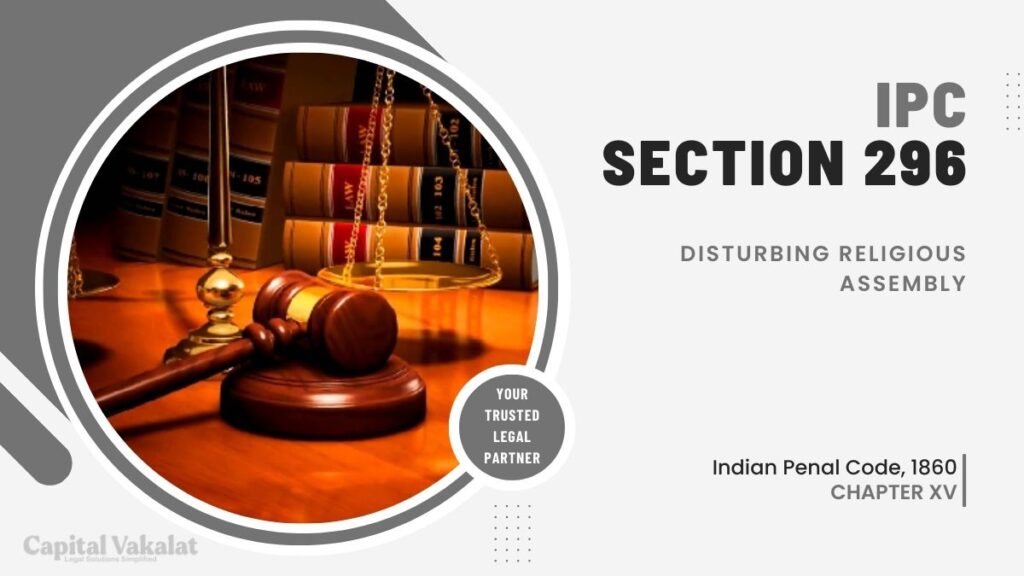In the tapestry of legal statutes that shape our society, Section 296 IPC stands as a sentinel, addressing a delicate subject – disturbing religious assembly.

This article delves into the intricacies of Section 296 IPC, unraveling its provisions and implications. From understanding the core elements to exploring real-life scenarios, let’s embark on a journey through the legal nuances that define this section.
Introduction: Decoding Section 296 IPC
Navigating the complex realm of legal jargon can be akin to traversing a labyrinth. Section 296 IPC, a significant component of India’s legal framework, deals explicitly with disturbing religious assembly. The section aims to maintain communal harmony by safeguarding religious congregations from unwarranted disruptions.
The Core Elements: Unpacking Section 296
To comprehend the essence of Section 296 IPC, it is vital to dissect its core elements. The section prohibits any act that causes disturbance or obstruction during a religious assembly, raising pertinent questions about what constitutes disturbance and the repercussions attached.
Understanding the legal lexicon is paramount here. ‘Disturbance’ implies any action that hampers the tranquility of a religious gathering, while ‘assembly’ encompasses any congregation organized for religious purposes. It’s a delicate balance between freedom of expression and the right to practice one’s religion without hindrance.
Real-life Scenarios: Navigating the Grey Areas
In the courtroom, the shades of grey often blur the line between guilt and innocence. Real-life scenarios involving Section 296 IPC highlight the challenges faced by both law enforcement and citizens. From protests near religious sites to artistic expressions that inadvertently cross the line, the application of this section is subjective and context-dependent.
Imagine an artist staging a performance near a religious procession – is it a form of expression or a disturbance? Section 296 IPC forces us to confront such dilemmas, emphasizing the need for a nuanced approach to maintain the delicate balance between freedom of expression and religious sentiments.
The Legal Conundrum: Balancing Act or Tightrope Walk?
As we navigate the legal conundrum surrounding Section 296 IPC, it becomes evident that finding the right balance is akin to walking a tightrope. On one hand, the section protects the sanctity of religious assemblies; on the other, it must not stifle legitimate expressions of art, speech, or protest.
The judiciary, in interpreting Section 296, has a challenging task at hand. Decisions must weigh the potential disturbance against the fundamental rights of individuals. In this legal tightrope walk, judges play a crucial role in shaping the contours of how Section 296 IPC is applied and understood.
The Evolution: Section 296 IPC in Changing Times
Law is not static; it evolves with societal changes. Section 296 IPC, drafted decades ago, now grapples with the complexities of a modern, interconnected world. The digital age has brought forth new challenges, with virtual spaces becoming potential arenas for acts that could be deemed disruptive to religious assemblies.
As we ponder the evolution of Section 296 IPC, it becomes imperative to question whether the current legal framework adequately addresses the challenges posed by technological advancements. Can a law drafted in an era when virtual spaces were unheard of adapt to the nuances of the digital age?
Conclusion: Striking a Harmonious Chord
In conclusion, Section 296 IPC, though rooted in noble intentions, requires a delicate touch. The scales must balance the protection of religious sentiments with the freedom of expression guaranteed by the Constitution. As society evolves, so must our legal frameworks. A nuanced understanding and application of Section 296 IPC can help strike a harmonious chord, fostering an environment where both religious assemblies and individual rights coexist.
Frequently Asked Questions
Are there exceptions to Section 296 IPC?
While the section is broad in its scope, certain exceptions may apply, such as acts done in good faith and in the interest of public order. However, each case is unique, and exceptions are subject to judicial interpretation.
How has technology impacted the application of Section 296 IPC?
The digital age has brought new challenges, with the potential for disturbances in virtual spaces. Courts must now grapple with the question of whether Section 296 IPC is equipped to address disruptions in the online realm.
Can artistic expression be considered a disturbance under Section 296 IPC?
Artistic expression enjoys constitutional protection, but when it infringes upon religious assemblies, it may be subject to scrutiny under Section 296 IPC. The courts must weigh the artistic intent against potential disturbances.
What role does the judiciary play in shaping the application of Section 296 IPC?
The judiciary plays a crucial role in interpreting and applying Section 296 IPC. Judges must navigate the legal nuances, considering the context of each case to strike a balance between protecting religious assemblies and upholding individual rights.